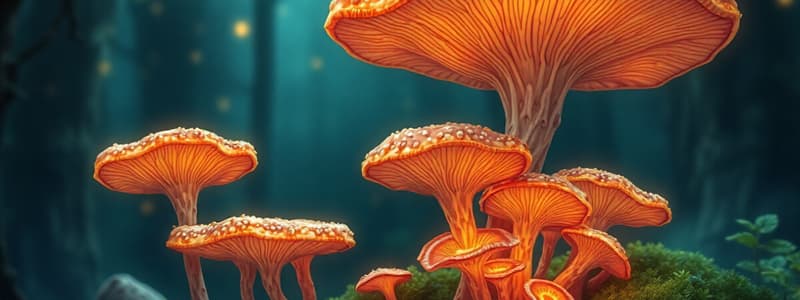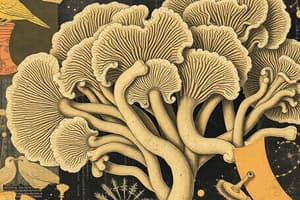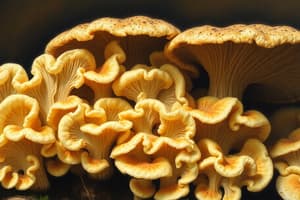Podcast
Questions and Answers
What distinguishes fungi from plants?
What distinguishes fungi from plants?
- Fungi produce seeds.
- Fungi contain chlorophyll.
- Fungi are heterotrophic. (correct)
- Fungi perform photosynthesis.
In mycorrhizal associations, what do fungi and plants exchange?
In mycorrhizal associations, what do fungi and plants exchange?
- Chlorophyll and carbohydrates.
- Nutrients and water. (correct)
- Seeds and spores.
- Air and sunlight.
Which of the following statements about fungi is true?
Which of the following statements about fungi is true?
- Fungi are more closely related to animals than to plants. (correct)
- Fungi are autotrophs that generate their own energy.
- Fungi are classified under the domain Prokarya.
- All fungi produce mushrooms.
What is a significant role fungi play in ecosystems?
What is a significant role fungi play in ecosystems?
Which of the following is not a way in which fungi can reproduce?
Which of the following is not a way in which fungi can reproduce?
Why are fungal infections difficult to treat in humans?
Why are fungal infections difficult to treat in humans?
What is an example of a mutualistic association involving fungi?
What is an example of a mutualistic association involving fungi?
What is the primary characteristic of Fungi belonging to the kingdom Eucomycota?
What is the primary characteristic of Fungi belonging to the kingdom Eucomycota?
What is the primary role of the photobiont in a lichen?
What is the primary role of the photobiont in a lichen?
Which component of a lichen is referred to as the mycobiont?
Which component of a lichen is referred to as the mycobiont?
How do lichens contribute to the formation of primitive soils?
How do lichens contribute to the formation of primitive soils?
What is the significance of lichen biomonitoring?
What is the significance of lichen biomonitoring?
Which of the following best explains why fungi form a symbiotic relationship with photobionts?
Which of the following best explains why fungi form a symbiotic relationship with photobionts?
What is the main structure of multicellular fungi responsible for nutrient absorption?
What is the main structure of multicellular fungi responsible for nutrient absorption?
Lichens are often used as indicators of environmental health. What do they absorb that serves this purpose?
Lichens are often used as indicators of environmental health. What do they absorb that serves this purpose?
What defines a lichen as a dual organism?
What defines a lichen as a dual organism?
Which type of hyphae allows fungi to penetrate host tissues and extract nutrients?
Which type of hyphae allows fungi to penetrate host tissues and extract nutrients?
What distinguishes coenocytic hyphae from septate hyphae?
What distinguishes coenocytic hyphae from septate hyphae?
What is the approximate number of lichen species identified worldwide?
What is the approximate number of lichen species identified worldwide?
Which of the following statements regarding fungal oxygen requirements is correct?
Which of the following statements regarding fungal oxygen requirements is correct?
What component primarily makes up the cell walls of most fungi?
What component primarily makes up the cell walls of most fungi?
What is the term used for tiny holes in fungal septa that facilitate nutrient flow?
What is the term used for tiny holes in fungal septa that facilitate nutrient flow?
What type of environment do fungi generally thrive in?
What type of environment do fungi generally thrive in?
How do yeasts differ in oxygen utilization compared to obligate aerobes?
How do yeasts differ in oxygen utilization compared to obligate aerobes?
What is the primary method of asexual reproduction in fungi?
What is the primary method of asexual reproduction in fungi?
Which of the following accurately describes the phylum Chytridiomycota?
Which of the following accurately describes the phylum Chytridiomycota?
What distinguishes Deuteromycota from other fungal phyla?
What distinguishes Deuteromycota from other fungal phyla?
Which aspect is NOT used to classify fungi?
Which aspect is NOT used to classify fungi?
How do spores benefit fungi in terms of reproduction?
How do spores benefit fungi in terms of reproduction?
What is the primary role of ribosomal RNA sequences in fungal classification?
What is the primary role of ribosomal RNA sequences in fungal classification?
Which characteristic is shared by all members of the kingdom Fungi?
Which characteristic is shared by all members of the kingdom Fungi?
Which of the following statements about chytrids is correct?
Which of the following statements about chytrids is correct?
What role do fungi play in the survival of trees and grasses?
What role do fungi play in the survival of trees and grasses?
Which fungi are specifically known for being used in cheese production?
Which fungi are specifically known for being used in cheese production?
What process do yeasts perform to create alcoholic beverages?
What process do yeasts perform to create alcoholic beverages?
Which of the following antibiotics is obtained from fungi?
Which of the following antibiotics is obtained from fungi?
What is the role of Beauveria bassiana in agriculture?
What is the role of Beauveria bassiana in agriculture?
What impact do fungi have on soil fertility?
What impact do fungi have on soil fertility?
Louis Pasteur is known for developing a reliable strain of which of these yeasts?
Louis Pasteur is known for developing a reliable strain of which of these yeasts?
Which drug isolated from fungi is known to reduce the risk of organ transplant rejection?
Which drug isolated from fungi is known to reduce the risk of organ transplant rejection?
Flashcards are hidden until you start studying
Study Notes
Introduction
- Fungi are eukaryotic organisms characterized by a true nucleus and membrane-bound organelles.
- There are approximately 100,000 identified species of fungi, representing only a fraction of the estimated 1.5 million species on Earth.
- Fungi play a critical role in ecosystems as decomposers, breaking down organic matter and contributing to nutrient cycling.
- They exhibit symbiotic relationships with other organisms, particularly plants, forming mycorrhizae.
- Fungi lack chlorophyll and are heterotrophic, obtaining energy and carbon from complex organic compounds.
- They reproduce both asexually and sexually, with some species exhibiting alternation of generations.
Fungal Structure and Morphology
- Fungi are characterized by a vegetative stage consisting of hyphae: slender, thread-like structures.
- Hyphae are interconnected to form a mycelium: a network of branched hyphae optimized for nutrient absorption.
- Most fungi have cell walls composed of chitin.
- Certain fungi possess specialized hyphae called haustoria, enabling them to penetrate host tissues and extract nutrients.
- Hyphae can be septate (divided into separate cells by septa) or coenocytic (lacking septa, forming large cells with multiple nuclei).
Fungal Habitat and Growth
- Fungi thrive in moist and slightly acidic environments, with variations in oxygen requirements.
- Most fungi are obligate aerobes, requiring oxygen for survival.
- Some species, like Chytridiomycota inhabiting cattle rumen, are obligate anaerobes, intolerant of oxygen.
- Yeasts are facultative anaerobes, thriving in oxygen-rich conditions but capable of surviving using anaerobic respiration.
Asexual Reproduction in Fungi
- The most common mode of asexual reproduction is through the formation of asexual spores.
- Asexual spores are produced by a single parent via mitosis and are genetically identical to the parent.
- Spores facilitate dispersal and colonization of new environments.
- Spores are released from the parent either externally or within a reproductive sac known as a sporangium.
Classification of Fungi
- Fungi are traditionally categorized based on colony appearance, hyphal organization, and reproductive spore structure.
- Modern classification relies on ribosomal RNA sequences.
- The fungal kingdom encompasses five major phyla: Chytridiomycota, Zygomycota, Ascomycota, Basidiomycota, and Deuteromycota.
- The Deuteromycota is an informal group of fungi characterized by exclusive asexual reproduction.
Chytridiomycota (Chytrids)
- Chytrids are aquatic fungi, some inhabiting freshwater and marine environments.
- Distinct from other fungi, they possess flagellated spores and gametes.
- Some chytrids are unicellular, while others form mycelia.
Lichens
- Lichens are a mutualistic association between a fungus (mycobiont) and a photosynthetic organism (photobiont, typically an alga or cyanobacterium).
- There are around 17,000 lichen species worldwide.
- The lichen's scientific name corresponds to the mycobiont, regardless of the photobiont's identity.
- Lichens play a vital role in environmental processes, including nitrogen fixation and biological weathering.
- They are sensitive to pollution, serving as indicators of environmental health.
Economic Importance of Fungi
- Fungi are essential to human life, contributing to medicine, agriculture, and food production.
- They produce antibiotics, maintain soil fertility, are consumed as food, and serve as a basis for various industries.
- Fungal pesticides, like Beauveria bassiana, are being investigated to control invasive insects.
- Fungi, along with bacteria, are crucial decomposers, recycling organic matter and enriching soil fertility.
- Fungal fermentation processes are involved in beer and wine production.
- Fungi are sources for various drugs, including antibiotics, immunosuppressants, and steroid hormone precursors.
Key Examples of Fungi and their applications
- Penicillium notatum is the producer of the antibiotic penicillin.
- Saccharomyces cerevisiae, a brewer's yeast, is utilized in beer production and biotechnology.
- Cyclosporine, an immunosuppressant drug, is derived from fungi.
- Molds of the genus Penicillium are involved in cheese ripening.
Studying That Suits You
Use AI to generate personalized quizzes and flashcards to suit your learning preferences.




